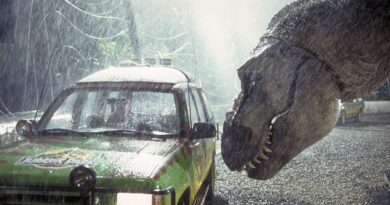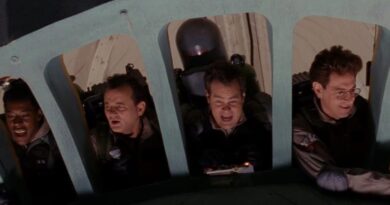Alien (1979)
The broad plot description of Alien reads like that of a particularly uninspired B movie, a retread of It! The Terror from Beyond Space: A spaceship lands on an unknown planet and the crew members subsequently bring on board a malevolent extraterrestrial life form, which then proceeds to kill them one by one. This easily calls to mind images of a man in a latex fish costume lumbering down shiny chrome corridors while astronauts in bubble helmets nervously clutch antimatter ray guns. From the visuals to the tone to the casting to the characterizations to the dialogue, this movie transcends all genre expectations. Here is a dark, deliberately paced, genuinely frightening movie that relies more on dread and primal reactions than on cheap thrills and flashy special effects. The filmmakers have bothered to take the subject matter seriously, and it has paid off.
The first forty-five minutes or so are devoted to the establishment of setting and character. The latter is especially vital to the success of a horror movie. The less we know about any of the characters, the less inclined we are to care about them; if we’re not inspired to care about them, their eventual deaths will have no meaning apart from empty shock value. We’re introduced to the seven crew members of the commercial towing spaceship Nostromo, who are not space opera typecasts so much as intergalactic industrial employees, who are only referred to by their last names. They’re all a bit rough around the edges. They smoke, drink coffee, and tell dirty jokes. We see a clear division of labor, the lowly engineers repeatedly complaining about wages and creating tension with those higher in command. We see mistrust between those who do things by the book and those that seem to take matters into their own hands.
When automatically awakened from hypersleep on their voyage home, they discover that they haven’t yet reached Earth. They are, in fact, only about halfway there. This is because the ship’s computer received a transmitted signal from an unknown planet; per contractual obligation, they’re required to investigate the source of the transmission. The engineers, Parker (Yaphet Kotto) and Brett (Harry Dean Stanton), who always have something to bitch about, remind Captain Dallas (Tom Skerritt) that the Nostromo is for commerce, not for search-and-rescue missions. They might, however, be willing to make an exception if their monetary demands are met. The science officer, Ash (Ian Holm), eager for the opportunity to investigate an alien planet, has carefully studied their company’s contract and knows each and every clause. If they refuse to accept this mission, any potential shares are automatically forfeited.
They land on the planet, a primeval world of hazy skies and craggy terrain. An away team uncovers the source of the signal: A derelict spacecraft that juts into the scenery like a demonic crescent. An examination of the interior, a disturbing display of visceral biomechanical architecture, yields the discovery of an immense lower-deck chamber filled with gigantic eggs. One crew member, Kane (John Hurt), volunteers to make the descent into the chamber. An examination of the eggs, waist-high monstrosities with four petal-like flaps on top, reveals that they are in fact incubating some organic life form. Suddenly, one of the eggs opens up. Kane, anxious but clearly intrigued, leans in for a better look. He puts his face directly over the opening. And then…
To describe the rest of the film in detail would only destroy the apprehension and terror director Ridley Scott works so hard to create and maintain. Rest assured, an alien creature does somehow wind up on the Nostromo, and the crew members systematically become its prey. Although there is a certain degree of gore, including one of the most unsettling and shocking birthing scenes ever captured on film, never once does Scott allow Alien to devolve into a vomitorium of cheap splatter effects. He instead opts to let audiences do most of the work by relying on their imaginations. At best, we get quick glimpses of the creature and its acts of carnage; any opportunity for full exposure is deliberately obscured by fast editing and minimal lighting effects. The most effective death scene doesn’t even give us that much to go on. All we get is the sound of screaming over the ship’s intercom system.
Scott deserves praise for paying close attention to the visuals, from the worn industrial appearance of the Nostromo’s labyrinthine corridors to artist H.R. Giger’s surreal designs of the alien spacecraft and the creature itself. But the greatest success of Alien is that it plays on our most basic human fears – fear of the dark, fear of death, fear of not being in control, fear of being watched, fear of the unknown. At the same time, it exemplifies how some of us are able to use those fears as a motivating force for survival. Pay close attention to a character named Ripley (Sigourney Weaver), a constant presence who has a bigger role to play that it might initially seem. Like her crewmates, she’s an ordinary person thrust into an extraordinary situation. Any hope of making it off the ship alive will depend not on heroine-like strength of character, but rather on basic ingenuity and luck.




